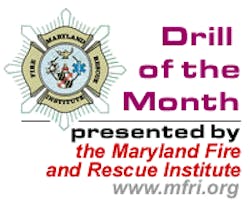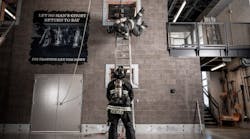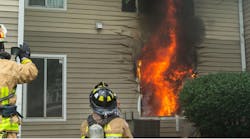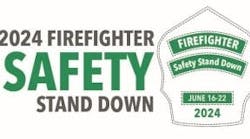North American Emergency Response Guide
Session Reference: 1
Topic: North American Emergency Response Guide
Level of Instruction: 3
Time Required: 2-3 hours
Materials:
. Chalkboard
. NAERG Books
. Placards or Placards Chart
. Slides of vehicles with placards found in your area
References:
. North American Emergency Response Guide Book
. Hazardous Materials for First Responders. IFSTA 2nd Edition
. MFRI Hazardous Materials Operations Program
PREPARATION:
Motivation:
The North American Emergency Response Guide Book is one that all emergency responders need to be familiar with. It is carried on every emergency vehicle in your department, and every call that you respond on (vehicle accident, building fire, or medical emergency) could require using it.
Objective (SPO): 1-1
The student will be able to from memory and without assistance, the four color sections of the North American Emergency Response Guidebook, and be able use it on a incident.
Overview:
Review of the Four Different Color Sections of the NAERG
. Yellow Section of materials by Identification Numbers
. Blue Section of materials by Name
. Orange Section of Guides for dealing with material
. Green Section of Initial Isolation and Protective Action Distances
Session 1 Using the NAERG Book
SPO 1-1 The student will be able to identify, from memory and without assistance, the sections in the NAERG book, and its use on a incident.
1-1 Describe the use of the four digit identification numbers used in the NAERG.
1-2 Describe the Yellow Section of the NAERG, how it is used to identify a material, and what guide to use to handle an incident dealing with the material.
1-3 Describe the Blue Section of the NAERG, how it is used to identify a material, and what guide to use to handle an incident dealing with the material.
1-4 Describe the Orange Section of the NAERG, the purpose of the guides in this section, and how to use it on an incident.
1-5 Identify the Green Section of the NAERG, the purpose of this section, and how to use it on an incident.
1-6 Using all the sections of the NAERG the student will be able to identify how to deal with a incident dealing with a chemical disclose.
I. Four Digit Identification Numbers (1-1)
A. Purpose of Numbers
1. Internationally developed numbers used so that a user can identify the material, no matter what
language they speak.
2. Developed by the United Nations for International use.
3. Show examples of placards found in your area.
B. Use of Numbering System.
1. Using slides/overheads of placards show the students how the numbering system is used to identify
materials.
2. Have the students identify locations in their first due area that they could find placards used, and
what type of business it is.
II. Yellow Identification Section of Guide (1-2)
A. Purpose of the Section
1. Identifying hazardous materials by the four digit United Nations number on the placard or shipping
papers.
2. Identify the guide used for dealing with an incident that the number has identified.
B. Using the Yellow Section of NAERG
1. Materials listed by numerical order. (Approximately 3600 chemicals)
2. More than 1 chemical may have the same Identification number. (Example: 1203)
C. Activity for students.
1. Divide the class into small groups, and give each group 3-5 numbers to identify the chemical.
(Examples: 1923, 2054, & 3027)
2. Give each group 5-10 minutes to identify the chemical, and report their findings to the class.
III. Blue Identification Section of Guide (1-3)
A. Purpose of the Section
1. Identify the hazardous material by its proper name found on the shipping papers.
2. Identify the guide used for dealing with an incident that has the chemical name identified.
B. Using the Blue Section
1. Materials are listed alphabetically by proper chemical name. (Approximately 3600 chemicals)
2. Remind students that exact spelling of the chemical name is important. Many chemicals are spelled
almost the same. (Examples: Butylamine & N-Butylaniline.)
C. Activities for students.
1. Divide the class into small groups, and give each group 3-5 chemicals to identify using proper
chemical names. (Give group at least 1 chemical name that is close to other groups.)
2. Give each group 3-5 minutes to identify the chemicals, and report to the class their findings.
IV. Orange Section of Guide (1-4)
A. Purpose of the Section.
1. Give the first responder on a hazardous materials incident, basic procedures for dealing with the
incident.
2. Remind the student that the information is for only protective actions, and is very generic.
B. Using the Orange Section of NAERG
1. Divided into 62 different guides.
2. Each guide is used for more than one chemical.
3. Guides are also divided into groups dealing with specific categories of chemicals. (Examples guides
115-126 deals with compressed gases.)
C. Activity for students.
1. Divide the class into small groups and give Each group 3-5 I.D. numbers and chemical names, and
identify the proper guide to use for each.
2. Give each group 3-5 minutes to identify the proper guide, and report it to the class.
V. Green Section of Guide (1-5)
A. Purpose of the Section.
1. To identify suggested isolation zone for chemicals that are identified as toxic from vapors of the
spilled chemical.
2. The Initial Isolation Zone is defined as the area surrounding the incident in which people may be
exposed to dangerous(upwind) and life threatening(downwind) concentrations of the material.
B. This section also contains a list of water reactive materials, that when mixed with water will produce a large amount of toxic fumes.
C. Using the Green Section of NAERG
1. Remember, when any chemical is highlighted in the Yellow or Blue section, the green section of the
Guide is used.
2. Chemicals are listed in U.N. number order in this section.
3. Review pages 298-299 in NAERG for determining out initial isolation and protective action
distances.
D. Activity for students.
1. Divide the class into small groups, and give each group a chemical, and have them determine the
proper isolation and protective actions distances for the chemical. (Both day & night conditions.)
2. Give each group 5-10 minutes to develop their plan.
VI. Putting all the Sections Together (1-6)
A. Review each Section.
1. Yellow Section of Guide (by ID numbers)
2. Blue
3. Orange Section of Guide (actions to take)
4. Green Section of Guide (Isolation & Protection Action Guide.)
B. Activity for Students.
1. Divide the class into small groups, and give each group 3-5 chemicals to identify, and what actions
they should take on a incident as a first responder.
2. At least one of the chemicals should be highlighted so that they must figure out an isolation, and
protective action distances.
3. Give each group 15-20 minutes to complete their work and report back to the class.
4. Review the problems as a class, and discuss any questions or concerns.
SUMMARY:
Review:
Review the Four Sections of the North American Emergency Response Guide
. Yellow Section by Identification Numbers
. Blue Section by Proper Names
. Orange Section by Action Guides
. Green Section by Initial Isolation and Protection Action Distances






